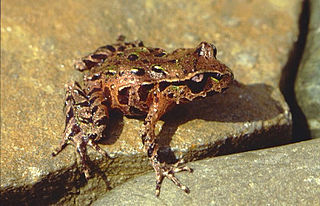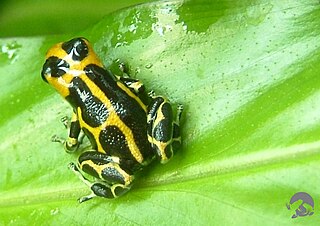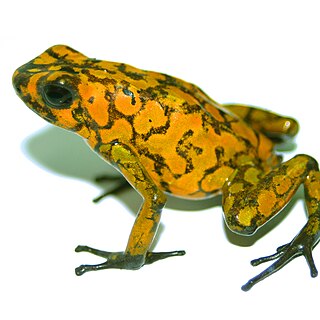
Perth Zoo is a 17-hectare (41-acre) zoological park in South Perth, Western Australia. The zoo first opened in 1898 and by 2011 housed 1258 animals of 164 species and an extensive botanical collection. It is a full institutional member of the Zoo and Aquarium Association (ZAA) and the World Association of Zoos and Aquariums (WAZA).

Poison dart frog is the common name of a group of frogs in the family Dendrobatidae which are native to tropical Central and South America. These species are diurnal and often have brightly colored bodies. This bright coloration is correlated with the toxicity of the species, making them aposematic. Some species of the family Dendrobatidae exhibit extremely bright coloration along with high toxicity, while others have cryptic coloration with minimal to no amount of observed toxicity. The species that have great toxicity derive this feature from their diet of ants, mites and termites. However, other species that exhibit cryptic coloration, and low to no amounts of toxicity, eat a much larger variety of prey. Many species of this family are threatened due to human infrastructure encroaching on their habitats.

Chester Zoo is a zoo at Upton-by-Chester, Cheshire, England. Chester Zoo was opened in 1931 by George Mottershead and his family. It is one of the UK's largest zoos at 51 hectares. The zoo has a total land holding of approximately 160 hectares.

The blue poison dart frog or blue poison arrow frog is a poison dart frog found in the forests surrounded by the Sipaliwini Savanna, which is located in southern Suriname and adjacent far northern Brazil. D. tinctorius azureus is also known by its indigenous Tirio name, okopipi. Its scientific name comes from its azure (blue) color. While frequently considered a valid species in the past, recent authorities treat it as a variant of D. tinctorius.

Captive breeding, also known as captive propagation, is the process of keeping plants or animals in controlled environments, such as wildlife reserves, zoos, botanic gardens, and other conservation facilities. It is sometimes employed to help species that are being threatened by the effects of human activities such as climate change, habitat loss, fragmentation, overhunting or fishing, pollution, predation, disease, and parasitism.

The strawberry poison frog, strawberry poison-dart frog or blue jeans poison frog is a species of small poison dart frog found in Central America. It is common throughout its range, which extends from eastern central Nicaragua through Costa Rica and northwestern Panamá. The species is often found in humid lowlands and premontane forest, but large populations are also found in disturbed areas such as plantations. The strawberry poison frog is perhaps most famous for its widespread variation in coloration, comprising approximately 15–30 color morphs, most of which are presumed to be true-breeding. O. pumilio, while not the most poisonous of the dendrobatids, is the most toxic member of its genus.

The dyeing dart frog, cobalt poison frog, dyeing poison dart frog, tinc, or dyeing poison frog is a species of poison dart frog. It is among the largest species, reaching lengths of 50 mm (2.0 in). This species is distributed throughout the eastern portion of the Guiana Shield and Venezuela, including parts of Guyana, Suriname, Brazil, and nearly all of French Guiana.

The green-and-black poison dart frog, also known as the green-and-black poison arrow frog and green poison frog, is a brightly-colored member of the order Anura native to Central America and northwestern parts of South America. This species has also been introduced to Oahu, Hawaii in an effort to lower mosquito numbers. It is one of the most variable of all poison dart frogs, after D. tinctorius and some Oophaga spp. From a conservation standpoint, it is considered to be of least concern by the International Union for Conservation of Nature. Within the reptile and amphibian hobby, D. auratus remains one of the most commonly kept, and easiest-to-breed, dart frogs in captivity, as well as in zoos.

The yellow-banded poison dart frog, also known as yellow-headed poison dart frog or bumblebee poison frog, is a poison dart frog from the genus Dendrobates of the family Dendrobatidae.

Archey's frog is an archaic species of frog endemic to the North Island of New Zealand. It is one of only three extant species belonging to the taxonomic family Leiopelmatidae. It is named after Sir Gilbert Archey, the former director of the Auckland Institute. The holotype is held at the Auckland War Memorial Museum. It is found only in the Coromandel Peninsula and near Te Kuiti in the North Island of New Zealand. This species, along with others in the family, have changed little over the past 200 million years, thus they represent "living fossils".

The golden poison frog, also known as the golden dart frog or golden poison arrow frog, is a poison dart frog endemic to the rainforests of Colombia. The golden poison frog has become endangered due to habitat destruction within its naturally limited range. Despite its small size, this frog is among the most poisonous animals on the planet.

Phyllobates bicolor, or more commonly referred to as the Black-legged poison dart frog, is the world's second-most toxic dart frog. Under the genus Phyllobates, this organism is often mistaken as Phyllobates terribilis, the golden poison frog, as both are morphologically similar. However, Phyllobatesbicolor is identifiable by the yellow or orange body and black or dark blue forelimbs and hindlegs, hence the name black-legged dart frog. Phyllobates bicolor are commonly found in tropical forests of the Chocó region of Colombia. The diurnal frogs live along the rainforest ground near streams or puddles that form. Notably, P. bicolor is a member of the family Dendrobatidae, or poison dart frog. P. bicolor, along with the rest of the Phyllobates species, produce a neurotoxin known as a batrachotoxin that inhibits specific transmembrane channels in cells. Due to this highly deadly toxin that the frogs secrete, many indigenous groups of the Colombian rainforest have extracted the toxins to create poison tipped darts used for hunting. During the breeding period, P. bicolor emits high pitched single notes as a mating call. As in all poison dart frogs, it is common for the father of tadpoles to carry the offspring on his back until they reach a suitable location for the tadpoles to develop. P. bicolor is an endangered species according to the IUCN red list. Currently, deforestation, habitat loss, and pollution pose the biggest threat to the species. Limited conservation efforts have been attempted to prevent further damage to the species. Despite this, there are still institutions such as the Baltimore National Aquarium in Baltimore, Maryland and the Tatamá National Natural Park in Colombia that are engaged in P. bicolor conservation efforts such as captive breeding.

Dendrobates is a genus of poison dart frogs native to Central and South America. It once contained numerous species, but most originally placed in this genus have been split off into other genera such as Adelphobates, Ameerega, Andinobates, Epipedobates, Excidobates, Oophaga, Phyllobates and Ranitomeya, leaving only five large to medium-sized species in the genus Dendrobates. All the other genera used to be grouped in with Dendrobates because it was previously thought that all brightly colored poison dart frogs came from the same ancestor but this has since been proven to be incorrect. Dendrobates and Phyllobates evolved conspicuous coloration from the same common ancestor but not the same as any of the other genera listed above.

Epipedobates is a genus of poison dart frogs native to northern South America west of the Andes, including the western slopes. Common name phantasmal poison frogs has been suggested for the genus.

Nandankanan Zoological Park is a 437-hectare (1,080-acre) zoo and botanical garden in Bhubaneswar, Odisha, India. Established in 1960, it was opened to the public in 1979 and became the first zoo in India to join World Association of Zoos and Aquariums (WAZA) in 2009. It also contains a botanical garden and part of it has been declared a sanctuary. Nandankanan, literally meaning The Garden of Heaven, is located near the capital city, Bhubaneswar, in the environs of the Chandaka forest, and includes the 134-acre (54 ha) Kanjia lake.

Ranitomeya imitator, is a species of poison dart frog found in the north-central region of eastern Peru. Its common names include mimic poison frog and poison arrow frog, and it is one of the best known dart frogs. It was discovered in the late 1980s by Rainer Schulte who later split it up into more subspecies; describing each as a specific color morph, and sometimes having a separate behavioral pattern. The acoustics, morphs, and behavior of the species have been extensively researched.

Vuze is a BitTorrent client used to transfer files via the BitTorrent protocol. Vuze is written in Java, and uses the Azureus Engine. In addition to downloading data linked to .torrent files, Azureus allows users to view, publish and share original DVD and HD quality video content. Content is presented through channels and categories containing TV shows, music videos, movies, video games, series and others. Additionally, if users prefer to publish their original content, they may earn money from it.

Panaʻewa Rainforest Zoo is located in Hilo, Hawaiʻi, United States. This small 12-acre (4.9 ha) zoo is the only one in the United States located in a rainforest. It is operated by Hawaii County and receives its funding from the county and from private donations.

Oophaga sylvatica, sometimes known as its Spanish name diablito, is a species of frog in the family Dendrobatidae found in Southwestern Colombia and Northwestern Ecuador. Its natural habitat is lowland and submontane rainforest; it can, however, survive in moderately degraded areas, at least in the more humid parts of its range. It is a very common frog in Colombia, but has disappeared from much of its Ecuadorian range. It is threatened by habitat loss (deforestation) and agricultural pollution and sometimes seen in the international pet trade.

Leptodactylus fallax, commonly known as the mountain chicken or giant ditch frog, is a critically endangered species of frog that is native to the Caribbean islands of Dominica and Montserrat. The population declined by at least 80% from 1995 to 2004, with further significant declines later. A tiny wild population remains on Dominica where there are efforts to preserve it, but few or none survive in the wild on Montserrat and its survival now relies on a captive breeding project involving several zoos. The initial decline was linked to hunting for human consumption, along with habitat loss and natural disasters, but the most serious threat now appears to be the fungal disease chytridiomycosis, which was the primary cause of the most recent rapid decline. On Montserrat it is known as the mountain chicken, while on Dominica it is known as the crapaud.


















